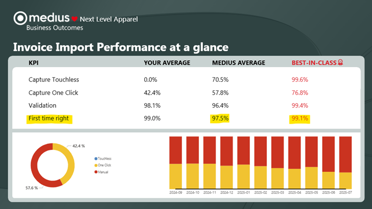Benchmarking AP accuracy and understanding acceptable invoice error rates
- Introduction
- Why invoice accuracy matters
- What is a good invoice error rate?
- Key metrics for benchmarking AP performance
- What’s holding AP teams back?
- How to calculate your invoice error rate
- Operational impact of invoice errors
- The role of AP automation in improving accuracy
- Benchmarking your performance against peers
- Best practices to improve AP accuracy
- Start tracking and improving your AP performance
Hear what's covered in this article:
As organizations seek to optimize cash flow, prevent fraud, and streamline operations, benchmarking AP accuracy has emerged as a critical performance indicator. This article explores what constitutes an acceptable invoice error rate, how leading AP teams benchmark their performance, and how automation solutions like Medius are essential to raising the bar.
Why invoice accuracy matters
Invoice errors are more than just operational annoyances. They lead to delayed payments, strained vendor relationships, lost early payment discounts, and even compliance risks. When multiplied across thousands of invoices, small mistakes quickly become large cost centers.
By benchmarking your AP accuracy, you gain insight into how well your team is performing against industry norms and competitors, and more importantly, how much value you may be leaving on the table.
What is a good invoice error rate?
The industry standard for an "acceptable" invoice error rate is often cited as 5% or less. However, leading AP teams target a much lower rate:
Best-in-class organizations achieve under 1%, with top performers reporting error rates as low as 0.8% or better.
At Medius, we refer to this benchmark as "First Time Right," representing the share of invoices processed without any errors or rework.
Recent customer benchmark data shows Medius clients average a 97.5% First Time Right rate (or a 2.5% error rate), with the best performers reaching 99.1% First Time Right (just 0.9% error rate).
Key metrics for benchmarking AP performance
To holistically assess AP accuracy and performance, consider tracking the following metrics:
| METRIC | DEFINITION |
| Invoice error rate | Percentage of invoices that contain incorrect data or require correction |
| Touchless processing rate | Share of invoices processed from receipt to approval without human intervention |
| Invoice processing time | Average number of days from invoice receipt to payment |
| Cost per invoice | Total cost of processing an invoice, including labor and system costs |
| Duplicate invoice detection rate | Percentage of duplicates detected before payment is issued |
| Invoice exception rate | Share of invoices flagged for issues like missing POs, incorrect amounts, or unmatched data |
What’s holding AP teams back?
Even teams that recognize the value of real-time reporting often hit roadblocks. Here’s what gets in the way:
- Process silos
- Manual workarounds
- Legacy systems
- Fraud blindspots
See how AI-powered automation tackles these roadblocks and opens a world of visibility with cutting edge reporting.
How to calculate your invoice error rate
Your invoice error rate can be calculated using a simple formula:

Total invoices with errors
Total invoices processed
Error Rate (%) = (Total invoices with errors / Total invoices processed) X 100
To monitor progress over time, track this metric monthly, quarterly, and annually alongside your other KPIs.
Operational impact of invoice errors
Even small error rates can add up fast:
- Errors delay approvals and vendor payments
- Incorrect payments can result in duplicate spend or compliance violations
- Manual exception handling drains staff time and morale
- Discrepancies in data can distort financial reporting and forecasting
This is especially critical in high-volume environments where accuracy at scale is essential.
- Manual data entry mistakes
- Mismatched POs and receipts
- Unclear or inconsistent invoice formats
- Missing fields or validation failures
- Duplicate submissions
- Non-compliant vendor behavior
Automation can address many of these root causes by enforcing validation rules, auto-matching invoice data, and streamlining approval workflows.
The role of AP automation in improving accuracy
AP automation platforms like Medius AP Automation and Medius Invoice Capture are purpose-built to:
Capture invoices digitally and standardize formats
Automatically match invoices to POs and receipts
Detect duplicates and flag anomalies using AI
Track KPIs to uncover performance gaps
Reduce processing costs and cycle time
With Medius, customers achieve on average:
70%+ touchless processing rates
2.5% average error rate
First Time Right rates up to 99.1%
Benchmarking your performance against peers
To stay competitive, AP teams need to benchmark performance against industry leaders. Here’s how Medius customers compare:

Best practices to improve AP accuracy
Implement automation to reduce manual entry and enforce rules
Use AI for anomaly detection and predictive error prevention
Standardize invoice formats and encourage vendor compliance
Establish vendor portals to streamline submission and validation
Set clear KPIs and track them regularly
Compare benchmarks with other teams to drive continuous improvement
Start tracking and improving your AP performance
Invoice error rates aren’t just a number, they’re a reflection of your finance team’s agility, accuracy, and strategic maturity. If your error rates are creeping above 5%, it’s time to assess your process and consider automation.
Contact our team to benchmark your own performance against peers and reduce your invoice error rate for good.








